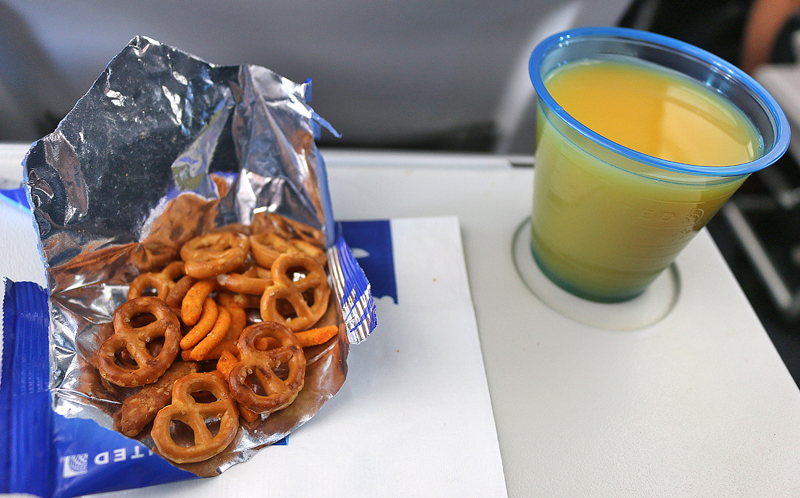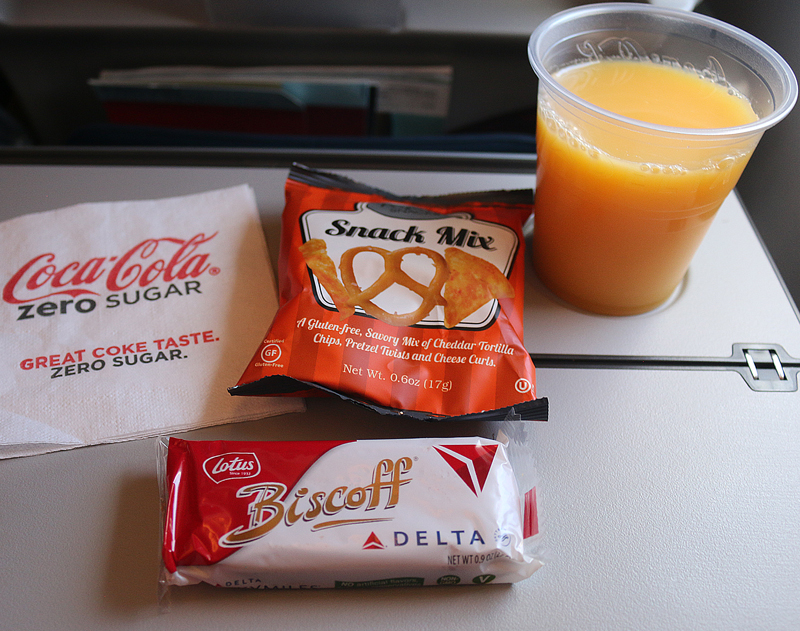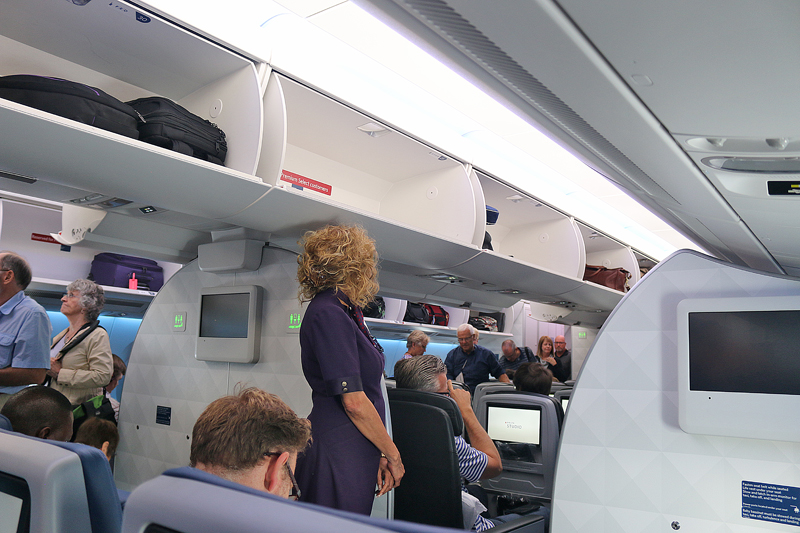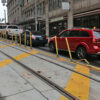Among the 14 topics of which the international president of the Association of Flight Attendants-CWA, AFL-CIO — which is a union that represents almost 50,000 flight attendants at 17 airlines — testified on Wednesday, April 21, 2021 before the United States Senate Committee on Commerce, Science, and Transportation’s Subcommittee on Aviation Safety, Operations and Innovation were those of proposals to minimize the food and beverage service aboard airplanes to maximize the usage of masks and coverings for the nose and mouth; and to require children who are two years of age and younger to be seated in their own seats while secured in child restraint seats.
Minimize Onboard Food and Beverage Service; No More Lap Children: Association of Flight Attendants

Starting on page 6 of the complete transcript of the official testimony by Sara Nelson is the following text which pertains to the proposal of minimizing the service of food and beverage to passengers aboard airplanes and limiting those offerings to essential items only:
A 2020 study of COVID-19 infection by occupation in Norway found that flight attendants and their counterparts working on ships reported nearly five times the risk of COVID-19 during the second wave of infection last summer and fall, as compared to the general working population in Norway, when matched by age and gender. The only jobs that posed a higher risk of COVID-19 during that time involved serving food and beverages. Even health care workers were at lower risk. The data is clear: repeated exposure to unmasked individuals increases the risk of transmission. For this reason, to protect passengers and flight crews, it is critical that food and beverage services continue to be held to absolute minimums.
Study after study confirms that wearing a mask is the single best protection against spreading and receiving COVID-19. Modeling data and population studies both show a strong effect, but only when masks are worn properly and consistently. As Americans, we are told to wear a mask in the grocery store and the doctor’s office,and if we were to remove our mask to eat a sandwich or sip a beverage in those environments, we’d be escorted off the premises. Flight attendants work in one of the most densely-occupied spaces in the world with windows that don’t open, doors that aren’t available most of the time, and limited ventilation.
Until the public health emergency is fully behind us, TSA and FAA must continue to send a consistent message about masking up to prevent onboard disease transmission, including mandatory, regular announcements for passengers to not remove their mask until the flight attendants have passed their row and, even then, to only “dip” their mask down momentarily to take a bite or sip (“dip and sip”). AFA recommends that airlines only serve cold food and drinks on flights less than 1,800 miles or three hours, that drinks are only distributed in individual cans/bottles, and that onboard alcohol sales are suspended until the pandemic is over.
Considering that masks and coverings for the nose and mouth are already required in both airports and aboard airplanes, the data is not so “clear” that the reduction of the service of food and beverages will actually improve health safety significantly, if you believe this article which was written by Sara Berg for the American Medical Association, which is the largest association and lobby group of physicians and medical students in the United States:
During air travel, the risk of COVID-19 is lower than from an office building, classroom, supermarket or commuter train, says the JAMA Patient Page, “Risk of COVID-19 During Air Travel,” co-written by Dr. Pombal.
“To date, the number of confirmed cases of COVID-19 transmission to airline passengers around the world is small,” said Dr. Pombal, adding that there have been only about “60 cases over a period in 2020 during which a total of over 1.2 billion passengers have travelled by air.”
“The odds of being on a plane with a person with actively transmissible COVID—both positive and in the window where they are significantly shedding as identified by the research—are quite low,” said Drs. Shoor and Ortega. However, “the best portion of the discussions and agreements revolve around the flexibility of response because one size doesn’t fit all.”
Also, people have been seen in grocery stores and medical offices without wearing their masks or coverings for their noses and mouths — whether or not they were eating a sandwich or sipping a beverage in those environments — and they likely were not escorted off the premises.
Finally, the statement by Sara Nelson does not address the serving of food and beverages to passengers aboard airplanes on flights which are greater than 1,800 miles or three hours in duration. Should that service be minimized for those flights as well? Perhaps serve a cold sandwich and a small bottle of water to each passenger for an international flight of 12 hours would be safer as well?
No More Lap Children: Seats to Be Required For All Passengers?

On page 9 of the aforementioned transcript is the following text which pertains to protecting children by requiring seats for all passengers:
If you visit the FAA’s website today, you would learn that federal safety officials consider the use of child restraint seats (CRS) the safest way for infants and small children to fly. The website is explicit that “[y]our arms aren’t capable of holding your child securely, especially during unexpected turbulence. However, the use of CRS remains a recommendation, twenty years after the American Academy of Pediatrics first called on the FAA to require CRS. Infants and children under the age of two continue to fly on laps without their own seat. It is past time to mandate flight protection for our youngest passengers, and as we consider social distancing and mask concerns it is certainly time to implement this regulation for the safety of our smallest passengers and everyone on board with them.
While requiring all passengers to sit secured in their own seats would technically be safer than infants and babies who sit on the lap and secured by the arms of a parent, how often is the infant or baby sitting on a lap really in danger — perhaps during sudden and violent turbulence?
According to this fact sheet from the Federal Aviation Administration of the United States, a total of 340 people — including 149 members of the flight crew — aboard airplanes have been injured as a result of turbulence during a flight between 2009 and 2018…
| Year | Passenger | Crew | Total |
|---|---|---|---|
| 2009 | 74 | 27 | 101 |
| 2010 | 35 | 23 | 58 |
| 2011 | 4 | 25 | 29 |
| 2012 | 4 | 19 | 23 |
| 2013 | 2 | 4 | 6 |
| 2014 | 19 | 9 | 28 |
| 2015 | 11 | 16 | 27 |
| 2016 | 29 | 13 | 42 |
| 2017 | 9 | 8 | 17 |
| 2018 | 4 | 5 | 9 |
…and although the National Transportation Safety Board of the United States requires airlines to report serious injuries and fatalities, no statistics seem to be available as to exactly how many of the 191 passengers who were injured by turbulence were babies or infants who sat on the laps of their parents over the duration of those ten years.
To put the figure of 340 injuries in some sort of perspective, one Boeing 777-300ER airplane can carry up to 386 passengers.
The prospect of fewer infants and babies seated aboard airplanes during flights — because some parents may not be willing or able to purchase an extra seat for travel — may delight those passengers who cannot stand to hear their screaming or crying or witness them being completely out of control.
Other Topics of the Transcript
The other 12 topics of the transcript of the testimony include:
- Payroll Support Program: a success for workers and a workers’-first model for the future
- Confidence in the safety of aviation
- Vaccinations are key
- Trade-Related Aspects of Intellectual Property waiver will help vaccinate the world
- Extending the Transportation Security Administration directive requiring mask wearing
- Unruly and violent passengers
- Keep airline workers and passengers safe from exposure
- Maximizing onboard ventilation and filtration
- Implementing effective disinfection and sanitation protocols will help restore passenger confidence
- Aviation can lead in protecting against the next crisis
- Aviation workers deserve access to job-protected sick time
- Accountability and neutrality in airline contracting and high quality jobs
Summary

The main job of a flight attendant is to ensure the safety of all passengers and members of the flight crew aboard airplanes from prior to leaving the gate to when everyone leaves the airplane — and thankfully, much of what they learn during weeks of training through which they endure rarely has to be implemented during an actual flight…
…but I cannot help but think that some of the proposals and recommendations which are included in the official transcript smacks of interests which seem more self serving than for the safety of the passengers they serve on every flight.
At least nowhere in the transcript under the heading of unruly and violent passengers is the suggestion of placing people on national “no-fly” list of misbehaved passengers — which was also proposed by Sara Nelson…
Photograph ©2015, ©2017, and ©2018 by Brian Cohen.

